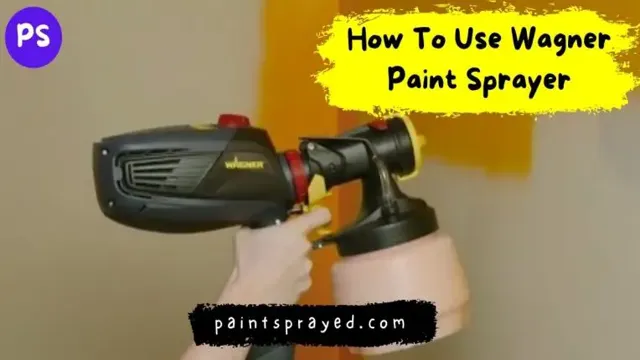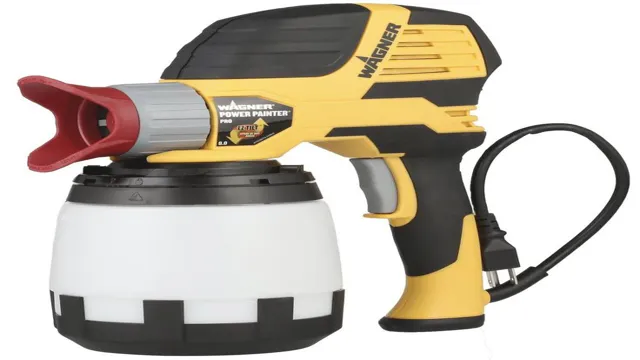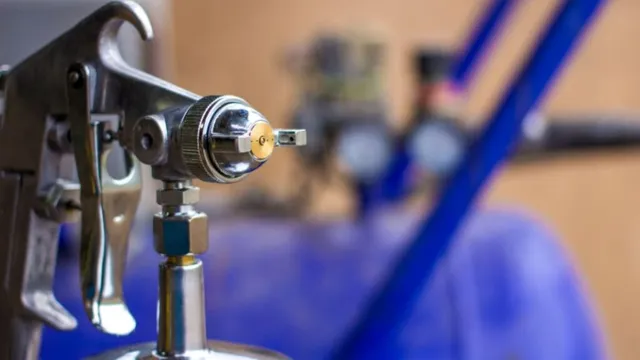Can You Use a Wagner Paint Sprayer Indoors and How to Do It Safely?

Do you want to revamp your indoor walls without spending a fortune on professional painters? A Wagner paint sprayer might be your solution! These painting tools can help you achieve a professional-looking finish at a fraction of the cost. However, before you start spraying away, it’s important to consider safety precautions, particularly if you’re using the sprayer indoors. In this blog, we’ll share some valuable tips to help ensure a smooth and safe indoor painting experience using a Wagner paint sprayer.
We’ll cover everything from proper ventilation to choosing the right paint and protect your belongings. So, let’s dive in and transform your indoor living spaces with ease and confidence!
Introduction
If you’re wondering if you can use a Wagner paint sprayer indoors, the answer is yes! However, it’s important to make sure you take the necessary precautions to ensure a safe and efficient painting experience. First and foremost, you’ll need to choose the right type of paint for indoor use. Water-based paints are typically the best choice because they emit fewer fumes and are easier to clean up.
It’s also essential to properly ventilate the room you’ll be painting in and wear protective gear such as a respirator mask and safety glasses. Additionally, it’s always a good idea to do a test spray on a small area first to make sure the sprayer is working correctly and to get a feel for the flow and coverage of the paint. With the proper preparation and precautions, using a Wagner paint sprayer indoors can be a great way to achieve professional-looking results in your home.
What is a Wagner Paint Sprayer?
Wagner paint sprayer Introduction: A Wagner paint sprayer is a tool used to apply a smooth and even layer of paint to any surface. It uses high-pressure air to atomize the paint and deliver it in a fine mist. Wagner sprayers come in different sizes and models for various painting tasks, from small DIY projects to large commercial jobs.
These sprayers are convenient and provide efficient performance, making painting faster and easier for both professionals and beginners. The Wagner paint sprayers are affordable and user-friendly, making them a popular choice for homeowners who want to do their own painting without the expense of hiring a professional. Let’s take a closer look at how Wagner paint sprayers work and their advantages over traditional painting methods.

Why Use a Wagner Paint Sprayer Indoors?
If you’re considering painting the interior of your home, you might be wondering if using a Wagner paint sprayer is a wise choice. The answer is a resounding yes! These devices make it easy to paint walls, ceilings, and other surfaces with professional-quality results. Not only can they save you time, but they can also help you achieve a smoother finish and even coverage.
By choosing a Wagner paint sprayer, you can avoid the hassle and mess of traditional brushes and rollers, and enjoy a cleaner, more efficient painting experience. So why not give it a try and see for yourself how much easier and more enjoyable indoor painting can be?
Safety Tips for Indoor Use
Painting the interiors of your home can be a fun project, but safety should always be a top priority. A common question that DIYers often ponder on is whether they can use a Wagner paint sprayer indoors. The answer is yes, but with some precautions in place.
Firstly, ensure that the room you are painting in is well-ventilated. Open the windows and doors to allow for proper ventilation of the room. Secondly, wear respiratory protection such as a mask or respirator to prevent inhalation of paint particles.
Lastly, cover all surrounding furniture, floors, and fixtures with drop cloths to avoid paint splatters and accidental spills. These safety tips will not only ensure that you stay safe while painting but also produce quality results when using a Wagner paint sprayer indoors.
Preparation and Ventilation
It is crucial to prepare and ventilate your indoor space when using certain products to ensure safety. When using chemicals like cleaning agents, paints, or adhesives, it is important to read and follow the instructions carefully. Wear appropriate protective gear like gloves and goggles while using these products.
To avoid inhaling dangerous fumes, ensure adequate ventilation by keeping windows open and using fans or open doors to create a cross-breeze. A poorly ventilated room can lead to respiratory problems and even fire hazards. Additionally, it is essential to remove any flammable items from the area, keeping them at least 10 feet away from the source of the fumes.
Remember, safety comes first, so take proper precautions before using any chemicals indoors.
Personal Protective Equipment (PPE)
When it comes to indoor safety, Personal Protective Equipment (PPE) is just as important as it is outdoors. Whether it be for household chores or work, wearing the right gear can protect you from potential hazards. Here are some safety tips for using PPE indoors.
Firstly, always make sure the equipment fits properly and is adjustable for your comfort. This includes items such as safety glasses, gloves, and helmets. Secondly, inspect the equipment before every use to ensure that it is in good condition and without any damage.
Thirdly, never reuse disposable PPE. Once they have been worn and disposed of, replace them with a new set. Fourthly, make sure to use PPE for the intended purpose.
Wearing a dust mask while painting, for instance, does not provide the level of protection needed for those fumes. Finally, store all PPE correctly in a dry and safe location to prevent contamination or damage. By following these guidelines, you can ensure that you are using PPE effectively and minimizing any risks to your health and safety.
Types of Paints to Use Indoors
When it comes to painting indoors, safety should always be your top priority. Regardless of the type of paint you are using, it’s important to take necessary precautions to protect yourself and those around you. One simple safety tip is to ensure proper ventilation in the room you are painting in.
Open windows and doors to allow fresh air in and fumes out. Additionally, always wear protective gear such as gloves, goggles, and a mask to prevent exposure to harmful chemicals. Another important factor to consider is choosing the right type of paint for your indoor project.
Water-based paints are a popular and safe option, as they emit fewer fumes and are easy to clean up with water. However, if you are painting in a high-traffic area or on a surface that requires durability, oil-based paints may be a better fit. Regardless of the type of paint you choose, following these safety tips will ensure a successful and healthy painting experience.
Using a Wagner Paint Sprayer Indoors: Step by Step Guide
Yes, you can definitely use a Wagner paint sprayer indoors, but you need to take some precautions before you begin. Firstly, make sure the area you’ll be spraying is covered with drop cloths to avoid any paint splatters. Open all the windows and doors to ensure proper ventilation while you are spraying.
You don’t want to inhale paint fumes, as it can be hazardous to your health. It’s also important to wear a respirator or a face mask to further protect you from inhaling any harmful vapors. Now it’s time to load the paint sprayer with your desired paint, but ensure it is well mixed, with no lumps or debris.
Adjust the spray nozzle to your preferred setting and start spraying, maintaining a consistent speed and distance. Once you’re done, give the paint a chance to dry before removing the drop cloths and any masking tape. With adequate preparation, you can achieve a professional-looking finish without any harm to yourself or others in your household.
So go ahead and utilize your Wagner paint sprayer indoors for that perfectly polished look!
Step 1: Preparing the Surface and Room
When it comes to using a Wagner paint sprayer indoors, it is crucial to ensure that you have properly prepared the surface and room before getting started. This step is critical, as it will determine how well the paint adheres to the surface and how much mess you’ll make. The first thing you need to do is clear the room of any furniture, decor, or other items that may get in the way.
Next, make sure that the surface you’re going to paint is clean and dry. You may need to sand it down or remove any old paint before beginning. Cover any areas in the room that you don’t want to accidentally spray with plastic sheeting or a drop cloth.
Lastly, ensure that you have proper ventilation in the room to avoid inhaling any fumes or Dust particles. With these steps completed, you’re ready to begin using your Wagner paint sprayer and achieving professional-looking results in the comfort of your own home.
Step 2: Setting up the Sprayer
When it comes to using a Wagner paint sprayer indoors, setting it up is an essential step. Start by making sure that you have all the necessary materials, including the sprayer, paint, drop cloths, and safety gear like goggles and a mask. Begin by setting up the sprayer itself, making sure that it’s clean and free of any debris or dust.
Then, attach the spray gun to the hose and ensure that it’s properly connected. Take the time to adjust the spray pattern and pressure settings to ensure that you achieve the desired finish and coverage. It’s also important to test the sprayer on a small scrap of material before you start painting to get a feel for the spray pattern and to make any necessary adjustments.
Once you’re satisfied with the setup, you’re ready to start painting your indoor surfaces efficiently and effectively. By following these steps, you can ensure that your Wagner paint sprayer will work well and give you the results you want.
Step 3: Applying the Paint
Once you have prepared your painting space and filled your Wagner paint sprayer with the chosen paint, it’s time to start applying it to your indoor surfaces. For best results, aim to hold the spray gun at a distance of around 6-8 inches from the surface and move it in a slow, sweeping motion. This will ensure even coverage and prevent any drips or bubbles.
Make sure to work in sections, overlapping each one slightly to guarantee a seamless finish. It’s also essential to keep your wrist and hand steady while painting, as any shaking or jerky movements will disrupt the paint flow and spoil the overall result. If you encounter any areas that require extra attention, you can go back over them once the first coat has dried.
With a little care and attention, using a Wagner paint sprayer indoors can give you a professional-quality result that will last for years to come.
Step 4: Cleaning Up After Use
Cleaning up after use is an essential step when using a Wagner paint sprayer indoors. First, make sure that all the paint has been emptied from the sprayer and that there is no residue left inside. Next, disassemble the paint sprayer and clean each part thoroughly.
You can use warm, soapy water or a cleaning solution recommended by the manufacturer. Rinse each part with clean water and dry them with a towel. Once all the parts are clean and dry, reassemble the sprayer, making sure that everything is securely tightened.
Store the sprayer in a safe place where it won’t be knocked over or damaged. By cleaning and properly storing your Wagner paint sprayer, you can ensure that it will be ready for use next time you need it. Remember, taking the time to clean up after use will help extend the life of your paint sprayer and ensure that it works properly the next time you need it.
Conclusion
In conclusion, whether you can use a Wagner paint sprayer indoors really depends on your individual situation and the type of paint you’re using. While Wagner sprayers are designed to be used indoors, it’s important to consider the potential risks of overspray and proper ventilation. So, before you break out your Wagner sprayer indoors, make sure you’ve taken all the necessary precautions to avoid any unwanted mess or fumes.
Happy painting, and may the spray be with you!”
FAQs
Is it safe to use a Wagner paint sprayer indoors?
Yes, Wagner paint sprayers can be used indoors as long as proper precautions are taken such as wearing a mask and ensuring proper ventilation.
How can I ensure proper ventilation when using a Wagner paint sprayer indoors?
Open windows and doors to allow fresh air to circulate, use fans to help circulate air, and consider using air purifiers to clean the air.
Can a Wagner paint sprayer be used on all surfaces indoors?
Wagner paint sprayers can be used on a variety of surfaces such as walls, ceilings, and furniture but it’s important to read the manual and choose the appropriate tip and settings for each surface.
Do I need to thin the paint before using a Wagner paint sprayer indoors?
Depending on the type of paint being used, it may need to be thinned before being used in a Wagner paint sprayer. Check the paint manufacturer’s instructions for guidance.
How do I clean my Wagner paint sprayer after using it indoors?
Follow the manufacturer’s instructions for cleaning the sprayer, but typically this involves flushing out the remaining paint with water or a cleaning solution and disassembling and cleaning individual parts.
Can a Wagner paint sprayer be used for small indoor projects?
Yes, Wagner paint sprayers are versatile and can be used for small indoor projects such as painting furniture or cabinets.
What are some tips for using a Wagner paint sprayer indoors?
Some tips include starting with a test project, taking breaks to avoid strain on the hands and wrists, and covering nearby items and surfaces with plastic to prevent overspray.



